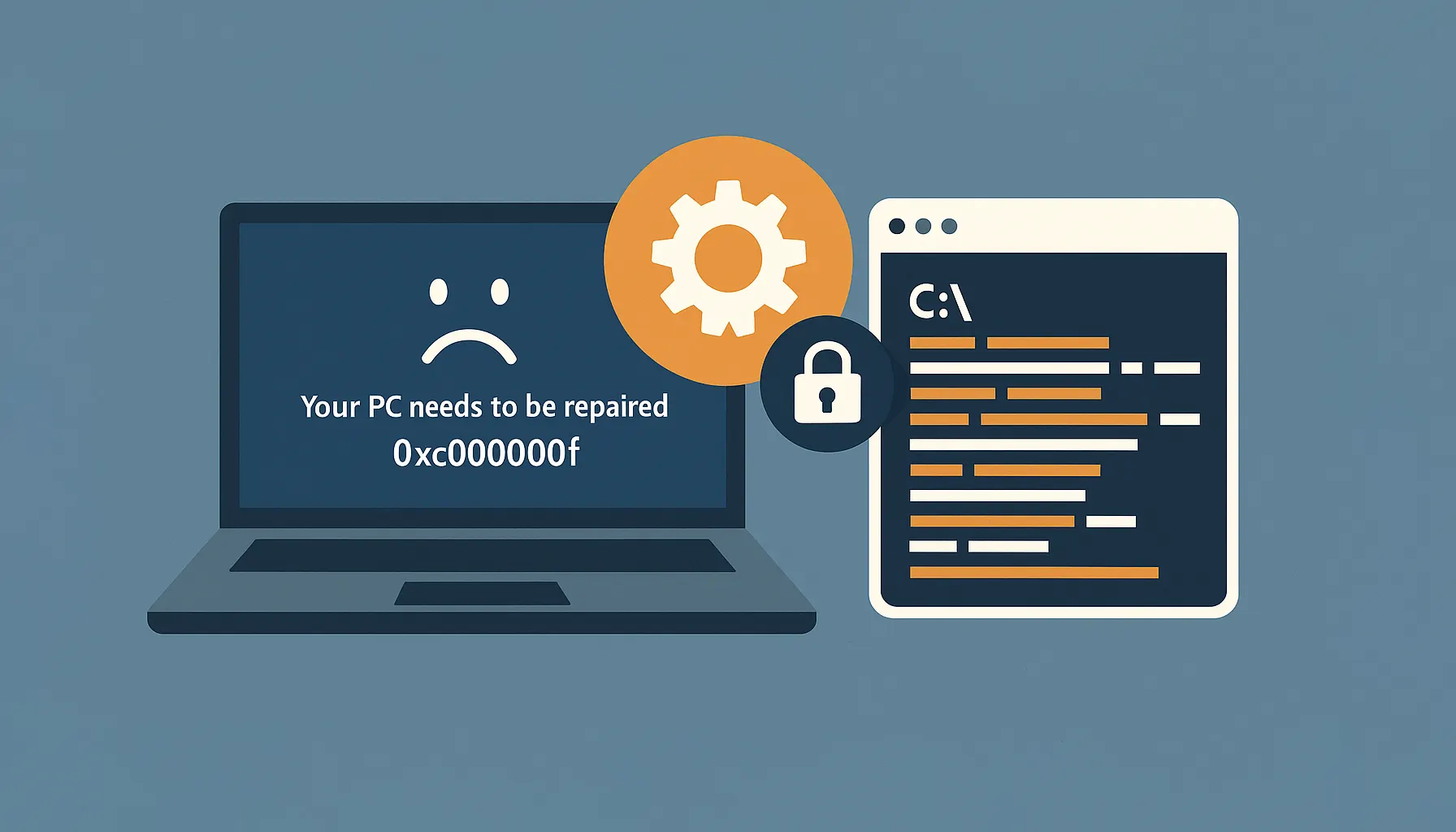Estimated Reading Time: 6 - 7 minutes
Fixing the 0xc00000f “Your PC needs to be repaired” error
If you're getting a blue screen on Windows 10 or Windows 11 bootup with an 0xc00000f error saying “Your PC needs to be repaired”, this indicates a problem with the Boot Configuration Data (BCD). This error can occur due to various reasons, including corrupted system files, problems with the hard drive, or issues with the boot sector.
Important Warning
The information provided in this document is intended for informational purposes only. Attempting to repair the Boot Configuration Data (BCD) involves modifying system files and can potentially lead to further system instability or data loss.
Always:
- Take a full backup of your data first.
- Test that backup to confirm it works.
- Proceed with caution and entirely at your own risk.
If you are unsure about any of the steps, we strongly recommend contacting a qualified technician or Telanova for support.
What You’ll Need
- Windows 10 or Windows 11 installation media (USB is recommended).
- Access to your device’s boot menu (usually a function key such as F2, F10, F12, DEL, or ESC).
- Your BitLocker recovery key (if your device is encrypted).
If your device is encrypted with BitLocker, you will need to get your recovery key from your Microsoft account before you start. Visit: https://aka.ms/myrecoverykey
Step 1: Prepare and Boot from Windows Installation Media
To fix the error, you need access to the Windows installation media.
- Create a Windows 10 or Windows 11 USB installer. The best option is to boot from a USB drive containing a Windows image. Use Microsoft’s official instructions by searching for “Create installation media for Windows” on the Microsoft website.
- Connect the USB drive to a USB port and restart your computer.
- Repeatedly press the key to enter the boot menu (commonly F2, F10, F12, DEL or ESC, depending on your computer's manufacturer).
- Select the USB drive as the boot device.
Step 2: Open Command Prompt from the Installer
- When you reach the Windows setup “Select language” screen, press Shift + F10 to open a Command Prompt window.
- Type the following command and press Enter:
diskpart - Select your system disk (in most cases this is
disk 0):select disk 0 - List the volumes on the selected disk:
list vol
Step 3: Identify and Assign a Letter to the EFI Partition
Now you need to find the EFI System Partition (ESP) and assign a drive letter to it.
- Look for the volume that:
- Is formatted as FAT32, and
- Is usually around 100–300 MB in size, and
- Often shows as System in the info column.
- Select that volume, replacing
<number>with the correct volume number:select vol <number> - Assign a drive letter that is not already in use (in this example, we use
T):assign letter=T - Exit DiskPart:
exit
Example DiskPart session:
DISKPART> select disk 0
Disk 0 is now the selected disk.
DISKPART> list vol
Volume ### Ltr Label Fs Type Size Status Info
---------- --- ----------- ----- ---------- ------- --------- --------
Volume 0 C NTFS Partition 237 GB Healthy Boot
Volume 1 Recovery NTFS Partition 529 MB Healthy Hidden
Volume 2 FAT32 Partition 99 MB Healthy System
DISKPART> select vol 2
Volume 2 is the selected volume.
DISKPART> assign letter=T
DiskPart successfully assigned the drive letter or mount point.
Step 4: Repair the EFI Bootloader in Windows 11
With the EFI partition mounted, you can now repair the bootloader.
- In the same Command Prompt window, change to the EFI Microsoft Boot folder (replace
Twith the letter you assigned to the EFI partition if different):cd /d T:\EFI\Microsoft\Boot\ - Rename the existing BCD store:
ren BCD BCD.old - Rebuild the BCD using the Windows installation on drive
C:(replaceT:if your EFI partition uses a different letter):bcdboot C:\Windows /s T: /f ALL - Close the Command Prompt and restart your computer.
If everything has worked correctly, Windows should now boot normally without the 0xc00000f error.
Disclaimer and When to Get Help
The instructions provided here are not a substitute for professional technical support. Repairing boot records and BCD stores can have unintended side effects, especially if partitions or drive letters differ from the examples above.
If you are not comfortable performing these steps, if your setup looks significantly different to the examples, or if the problem persists after following this guide, please contact a qualified technician or get in touch with Telanova on 01344 989 530 for assistance.
Frequently Asked Questions
What does the 0xc00000f error mean?
The 0xc00000f error usually indicates a problem with the Boot Configuration Data (BCD) or bootloader. Windows can’t find the files it needs to start correctly, which may be due to corruption, disk issues, or changes to partitions.
What if my drive is encrypted with BitLocker?
If BitLocker is enabled, you should obtain your BitLocker recovery key from https://aka.ms/myrecoverykey before making any changes. You may be prompted for this key when booting from installation media or after repairing the bootloader.
Can these steps cause data loss?
These steps focus on the bootloader and BCD, not on formatting or deleting partitions. However, any work on disks and system files carries risk. That’s why a full, tested backup is strongly recommended before you begin.
What if I don’t have Windows installation media?
You can create installation media on another working Windows PC using Microsoft’s official “Create Windows installation media” tool. If this isn’t possible, you may need help from an IT professional.
When should I call a professional instead of doing this myself?
If you are unsure about any of the commands, if your DiskPart output looks very different from the examples, or if you depend on the device for critical work, it’s safer to contact a professional or Telanova for support rather than risk further issues.
Need Help Repairing Your Windows Bootloader?
At Telanova, we help businesses across Wokingham, Ascot, Bracknell, Reading, and the wider Berkshire region diagnose and resolve Windows boot problems quickly and safely.
Whether you’re seeing 0xc00000f errors, BitLocker prompts, or repeated boot failures, we can step in, protect your data, and get you back up and running.
Explore our IT support services or call 01344 989 530 to talk through your issue with one of our experts.





